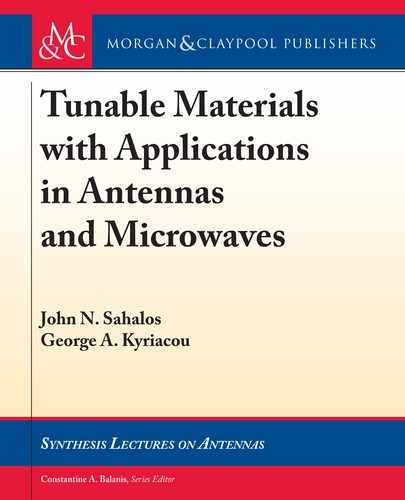
2.16. PEROVSKITE SUPERLATTICES 55
Typical representatives of quantum ferroelectrics are the perovskite crystals of STO (SrTiO
3
),
CaTiO
3
, and KTO (KTaO
3
). When an amount (x) of ppm, (parts per million), of impurities
is added to quantum ferroelectrics, the Curie–Weiss temperature (T
C
) is increased even up to
room temperature or higher. BSTO (BaxSr
1
–xTiO
3
) below T
C
exhibits a typical-conventional
ferroelectric-like behavior [48]. For this reason, quantum ferroelectrics are also called “incipient
ferroelectrics” since they constitute the basic component of which conventional ferroelectrics
are composed. e term “incipient ferroelectric” means that the material manifests dielectric
non-linearity but does not exhibit spontaneous polarization [48, 49]; that is, it has no polar
phase. According to Ang et al. [49], and the references therein, quantum paraelectrics show an
increase in the dielectric constant up to about 4 K, and then exhibit a levelling-off around 0 K.
A typical temperature dependence of the dielectric constant of incipient dielectrics for different
DC biasing electric fields is shown in Figure 2.25 [48, 49, 51].
9,000
8,000
7,000
6,000
5,000
4,000
3,000
2,000
1,000
0 100 200 300 400 500
0 2.0 4.0 6.0 8.0 10 kV/cm
DC Bias (V)
Permittivity
STO 1.0 kHz
35 K
45
65
75
85
55
Figure 2.25: Temperature dependence of the dielectric constant for the incipient dielectric
SrTiO
3
, (STO), vs. the DC bias voltage.
2.16 PEROVSKITE SUPERLATTICES
e undesired temperature dependence and the high microwave losses of perovskites in their
paraelectric phase have led material scientists to search for more advanced tunable materials.
Recently, e.g., [55], perovskite superlattices have been proposed for this purpose. A superlattice
comprises alternating, (usually epitaxial), layers of dissimilar paraelectric perovskites and may ex-
hibit large changes (tunability) in the dielectric constant with a variation of the applied DC bias
electric field. Not all the layers of a superlattice need to be tunable, but at least one should. Exper-
iments with superlattices composed of any suitable sequence of paraelectric SrTiO
3
, SrCeO
3
,
SrZrO
3
, BaTiO
3
, BaZrO
3
, CaZrO
3
, and LaAlO
3
layers have been conducted in the litera-
ture [56–65]. ey were fabricated with the aid of pulsed laser deposition, mostly on a LaAlO
3
substrate and some of them on a SrTiO
3
one. Superlattices can be made to have weak temper-
ature dependence and large tunability. For example, the SrTiO
3
/BaZrO
3
superlattice exhibits
..................Content has been hidden....................
You can't read the all page of ebook, please click here login for view all page.
